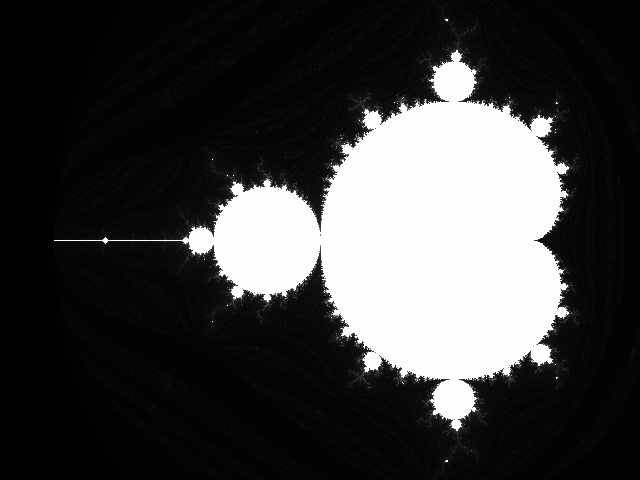I want to do some graphics on a PIC - so I need some "real" datatypes. But I'm not sure how many bits of fixed-point resolution I need. It's easy enough to code up fixed-point routines for any multiple of 8 bits, but I'd rather just do it once. So, I wrote some templated C++ code to simulate fixed-point types. Here's a 640x480 Mandelbrot set in 3.5 8-bit fixed point math (generated on a PC):

Not great. I knew I'd need more than 8-bits, though :-) Here's the same in 3.13 16-bits:

Much better. Of course, if you zoomed in, you'd need more bits of precision. You can test 24, 32, 40, 48, 56, or 64-bits with my trivial C++ class below. I started testing with fractals, because the algorithm is so simple: in my teens, I got it published as an Apple II BASIC one-liner in Nibble magazine. Anyway, templated over the datatypes, it looks like this:
template <typename iter_t, typename real_t>
iter_t
mandelbrot_test(real_t c, real_t d, iter_t max_iter, real_t max_mag)
{
real_t a, b;
a = real_t(0.);
b = real_t(0.);
iter_t i = 0;
while (i < max_iter){
real_t aa = a * a;
real_t bb = b * b;
if (aa + bb > max_mag){
break;
}
b = real_t(2.) * a * b + d;
a = aa - bb + c;
i++;
}
return i;
}
This is a direct translation of the floating-point algorithm; it could be improved some to avoid issues with fixed-point overflows.
So far, I've only implemented addition, subtraction, and multiplication, which is sufficient for these fractals:
template <int width, int scale>
class fixed_pt
{
public:
fixed_pt(int64_t val = 0)
: w(width),
s(scale),
v(val)
{
}
fixed_pt(double x)
: w(width),
s(scale)
{
v = int64_t((x * (int64_t(1) << w))) >> s;
if (x >= 0){
v &= 0xffffffffffffffffull >> (64-w);
} else {
v |= 0xffffffffffffffffull << (64-w);
}
}
operator double()
{
return v / double(int64_t(1) << (w-s));
}
friend fixed_pt operator+ (fixed_pt<width, scale> a, fixed_pt<width, scale> b)
{
return fixed_pt<width, scale>(double(a) + double(b));
}
friend fixed_pt operator- (fixed_pt<width, scale> a, fixed_pt<width, scale> b)
{
return fixed_pt<width, scale>(double(a) - double(b));
}
friend fixed_pt operator* (fixed_pt<width, scale> a, fixed_pt<width, scale> b)
{
return fixed_pt<width, scale>(double(a) * double(b));
}
private:
int64_t v;
int w;
int s;
};
Yes, it's a hack - meant in the worst pejorative sense - but it was easy to implement, and will give me some quick results without having to dive into embedded issues yet. Once I decide on the number of bits I need, I can start coding up some routines - I know I'll need at least these operations.
I'll also need division if I want to get ray-tracing going. Square roots are probably also necessary, and those can be implemented in terms of the other operations - they might not be fast, but who cares?
I didn't implement any colors here: I'm saving that for the embedded code :-)
Now, I can try some ray-tracing. That will take a little more time...
EDIT
So, I really should have done this first, but I was pretty sure of the answer. I just compiled the most bare-bones calculation of the above fractal in C using Microchips XC8 compiler, a PIC16 target, and "float" datatypes: 1565 instructions = 2738.8 bytes. Yeah, you can't just take the easy way.
 Ted Yapo
Ted Yapo
Discussions
Become a Hackaday.io Member
Create an account to leave a comment. Already have an account? Log In.